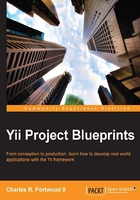
What this book covers
Chapter 1, A Task-management Application, covers developing a simple task-management application from the ground up using SQLite and basic database migrations. This chapter will cover all the moving parts of Yii and prepare you for working with more complex applications.
Chapter 2, Discovering What's Nearby, covers how to integrate the Yii framework with the Google Maps API to display information about what is near a given user. You'll also learn how to create command-line tools to handle importing and processing data.
Chapter 3, Scheduled Reminders, focuses on developing a multiuser web-based scheduling and reminders application that can notify users via e-mail when a scheduled event is about to occur.
Chapter 4, Developing an Issue-tracking Application, covers how to create a multiuser issue-tracking and management system, complete with an e-mail notification system using MySQL as a database backend. This chapter will also cover handling input from e-mail submissions to trigger actions within the application.
Chapter 5, Creating a Microblogging Platform, covers how to create your own microblogging platform similar to Twitter, complete with a robust user authentication and registration system. You'll also learn how to integrate your application with third-party social networks using HybridAuth, as well as how to streamline your headless development time with Composer.
Chapter 6, Building a Content Management System, covers how to create a feature-complete content management system and blogging platform that expands using the knowledge built upon in the previous chapters. This chapter will also demonstrate how to integrate with even more third-party open source libraries.
Chapter 7, Creating a Management Module for the CMS, focuses on the development of a management module for the content management system built in the previous chapter. In this chapter, you'll learn how to migrate data from controllers to a Yii module that can be reused and managed independently of the content management system.
Chapter 8, Building an API for the CMS, covers how to create a JSON REST API module for the content management system that can be used for both client-side web applications and native development. This chapter will cover the basics of creating a secure and authenticated JSON REST API, and will demonstrate how to adapt controller actions for JSON responses rather than web view responses.